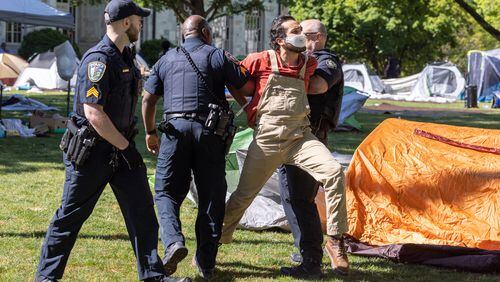This was your great-great granddaddy’s football:
No forward pass. A ball shaped like a casaba melon. Formations seemingly lifted from Attila the Hun’s playbook. Players who wore about as much protective gear as the swim team.
The aesthetics were lacking, and the danger was clear and present.
One yard and a cloud of body parts.
During the fall of 1905, three college players died as a result of game injuries (there were a reported 15 other deaths at lower levels that year). In an era of flimsy leather headgear and rules that transformed the game into one continual rugby scrum, it was a wonder the mortality rate wasn’t higher.
Yardage was ceded in such grudging increments that teams needed to gain but 5 yards over three downs for a first down. “A lot of pushing and pulling of ball carriers occurred. Sometimes, they catapulted the runner,” said John Sayle Watterson, author of “College Football: History, Spectacle, Controversy.”
Something had to give.
Mayhem, it turned out, was the mother of invention.
So concerned was he by the carnage that President Theodore Roosevelt invited representatives of various northeastern universities (the cradle of the game at the time) to meet at the White House and address the issues. By this stage, more than 20 schools were in the process of dropping football.
“You can look at 1906 as when the modern era of college football begins,” said Kent Stephens, historian and curator at the College Football Hall of Fame.
A loose form of college football had been practiced since 1869. But, in the early 1900s, so many more teams were competing, so many more players were at risk and so much more scrutiny was brought to bear that the game had become a matter of presidential interest.
Through Roosevelt’s prompting, the evolution of the college game sped up dramatically.
Before the summit, the game had been run by “athletic groups headed by former students, which hired the coaches and collected the gate receipts,” Stephens said. By the end of ’05, the sport collected beneath the umbrella of the Intercollegiate Athletic Association of the United States, a precursor of the NCAA.
The first forward pass was thrown in 1906 — the Saint Louis Billikens’ Bradbury Robinson hitting Jack Schneider on a 20-yard toss. There was much more work to be done, however, before that revolutionary concept gained wide acceptance. “Many coaches thought passing was a less manly approach to the game,” Stephens said.
Other rule changes spread players across the line of scrimmage, eliminating more hazardous formations.
By 1912, the lords of the game even decided a touchdown should be worth six points, not five; and that a field goal should count as three, not four, points.
Historians dispute the common perception that Roosevelt considered pulling the plug on football lest there come some meaningful changes. Stephens points out that the president had a son who was a freshman player at Harvard, and had suffered a broken nose during a 1905 game.
More likely, said Watterson, Roosevelt was concerned that “there was too much bad press that somebody else might actually try to eliminate it.”
Not to worry, though. College football was not going to turn into a sewing circle under the broad-shouldered administration of a former Rough Rider. An old quote from Roosevelt is peppered with anachronistic turns of phrase, but also contained a timeless sentiment about what’s still required when suiting up on a Saturday:
“I believe in outdoor games, and I do not mind in the least that they are rough games, or that those who take part in them are occasionally injured. I have no sympathy whatever with the overwrought sentimentality which would keep a young man in cotton-wool, and I have a hearty contempt for him if he counts a broken arm or collarbone as of serious consequence when balanced against the chance of showing that he possesses hardihood, physical address and courage.”
About the Author






